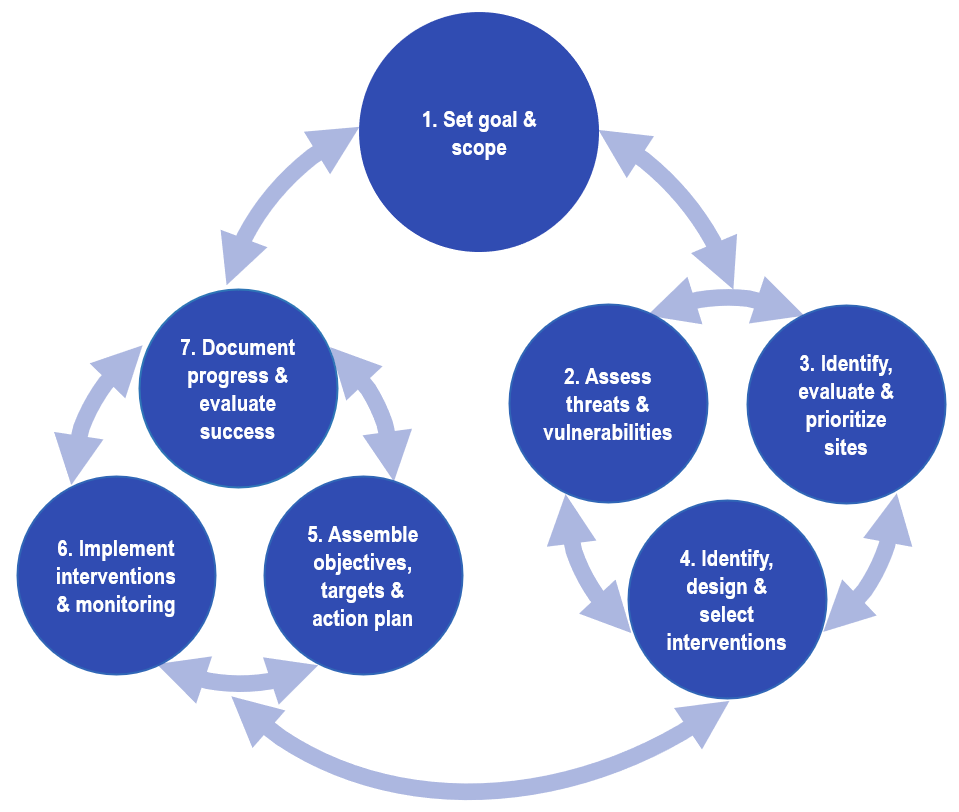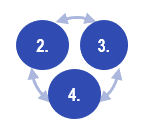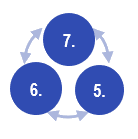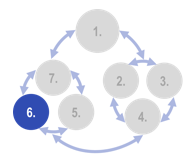Explore the Steps
Click on any bubble to explore the steps. Steps can be executed in any order as an iterative process, where information is revisited and improved through time as results of other steps become available. Step contents are meant to be flexible instead of prescriptive since certain step elements may have greater or lesser relevance depending on the project.




1. Set Goal & Scope

A clearly articulated goal is one that specifies the desired effect of a management effort in terms of what is to be achieved ecologically and socially, and over what time frame (years to decades).
The scope of the effort refers to the extent of area (geographic boundaries) and/or framing of social parameters (such as human economic brackets or community types) on which the work will focus.
Iterations of this step with any other steps could include: further refining the goal & scope based on the discovery process throughout the project; then returning to other steps for adjustments based on the updated goal & scope specifications.
Click here to read step 1 examples from different ecosystem projects:
Step 1 Inclusive Collaboration Best Practices
At the beginning of the project, engage broadly with representatives of public and partner groups, including historically marginalized groups, to ensure co-development of goals and scope that fit local social capacity and natural contexts.
Communicate and present information early and often, to build trust and respect and to advance knowledge exchange and co-learning.
For more detailed guidance, see Organon Collaboration Best Practices by Step.
2. Assess Threats & Vulnerabilities

An early critical task is to assess threats to the natural resource and associated human communities from local stressors, both natural and anthropogenic, and their interactions with large-scale climate change stressors.
The next stage is to assess vulnerabilities based on the degree of exposure to the threats plus the system's sensitivity and adaptive capacity to resist or recover.
Iterations with other steps could include: returning to refine step 1 goal & scope based on a deeper understanding of system vulnerabilities; or tailoring additional rounds of the vulnerability assessment to meet specific needs of step 3 site prioritization and step 4 intervention design.
Click here to read step 2 examples from different ecosystem projects:
Step 2 Inclusive Collaboration Best Practices
Work to combine public experiences and perceptions of threats and vulnerabilities with the best available scientific knowledge.
Develop a common understanding of threats and vulnerabilities and the possible effects of hazards to natural and built environments and diverse social groups.
Incorporate an understanding of how public and partner groups view sensitive topics around vulnerability in engagement and communication strategies.
For more detailed guidance, see Organon Collaboration Best Practices by Step.
3. Identify, Evaluate & Prioritize Site(s)

Within the defined geographic and social scope, it is necessary to identify site(s) that are smaller spatial units suitable in scale for implementing management projects or activities; in some cases, a single site may already be the focus.
The need to evaluate site(s) recognizes that sites can vary in their suitability for different interventions based on criteria such as relative contribution to the goal, current and future status of the resource, vulnerability, and management context.
Decision-making to prioritize site(s) for piloting and potential scaling-up of management activities to achieve the goal is based on review and discussion with appropriate management, experts, and other stakeholder groups.
Iterations with other steps could include: returning to step 2 vulnerability assessment for more specific information to inform site evaluation; or reconsidering site prioritizations based on changes to step 1 goal & scope or due to site-specific design limitations of potential step 4 interventions.
Click here to read step 3 examples from different ecosystem projects:
Step 3 Inclusive Collaboration Best Practices
Involve the public and partners in evaluating and prioritizing sites to reduce vulnerabilities to social, natural, and built systems, while working toward improved equity and justice in the benefits and costs of planning outcomes.
Consider using a neutral mediator to ensure fair conflict resolution and consensus in high conflict situations.
For more detailed guidance, see Organon Collaboration Best Practices by Step.
4. Identify, Design & Select Interventions

Proceeding to identify interventions involves brainstorming a full list of all available management actions that could be taken to address threats and vulnerabilities at sites selected as key to achieving the management goal.
Before making any choices, it is useful to assess how to design interventions by adapting components, configurations, timing, and other elements to ensure robustness under changing environmental conditions.
This makes it possible to select interventions based on evaluation criteria that include design effectiveness under both current and future conditions, along with other key determinants such as cost, feasibility, urgency, flexibility, and multiple benefits.
Iterations with other steps could include: returning to step 2 vulnerability assessment or step 3 site evaluation for more tailored information relevant to particular site-specific interventions; or redesigning interventions based on preliminary results from the step 5-7 implementation triad.
Click here to read step 4 examples from different ecosystem projects:
Step 4 Inclusive Collaboration Best Practices
Work with the public and partners toward a common understanding of the benefits and costs of each intervention for sustainable outcomes, with emphasis on diverse and disproportionately affected groups, community capacity, and environmental protection.
Show and explain how public input is included in site selection to continue building a sense of co-ownership, responsibility, and trust in the planning process.
For more detailed guidance, see Organon Collaboration Best Practices by Step.
5. Assemble Objectives, Targets & Action Plan

The transition from technical planning (steps 2-4) to practical implementation (steps 5-7) starts with the assembly of precise objectives that are Specific, Measurable, Achievable, Relevant, and Time-bound (SMART).
Such precision enables the creation of management targets that can function as stepping-stones along a path to achieving the objectives, by describing where and how each work element will be done under a defined implementation timeline.
The action plan then aggregates the full suite of interventions, objectives, targets, and timelines--tailored by site as appropriate--to guide the practical implementation of management activities to achieve the overall goal.
Iterations with other steps could include: adjusting the action plan as improved information becomes available from the step 2-4 planning triad, or based on preliminary results of step 6 implementation and step 7 evaluation pilots.
Click here to read step 5 examples from different ecosystem projects:
Step 5 Inclusive Collaboration Best Practices
Involve partners in developing an action plan with objectives and targets that allow for public celebration of incremental milestones.
Incorporate historically marginalized, underrepresented, and disproportionately impacted groups to ensure equitable representation.
Build on local capacities with an aim toward long-term capacity building and a smooth transition of responsibilities for sustained project success.
For more detailed guidance, see Organon Collaboration Best Practices by Step.
6. Implement Interventions & Monitoring

To implement interventions, the sequence and timing of activities in the action plan are now applied in the field, through initial pilot trials (where needed) that are then scaled-up to fully achieve objectives.
Monitoring to assess the efficacy of interventions in the initial phase of implementation should be expanded into a more comprehensive monitoring plan that specifies metrics and methods, measures of effectiveness, spatial scale and locations, timeframe, and roles and responsibilities for collecting data at the full scale of the longer-term effort.
Iterations with other steps could include: improving implementation and monitoring methods by seeking updated technical information from step 3 site evaluation and step 4 intervention design; or adaptively informing—and being informed by—steps 5 & 7 within the implementation triad.
Click here to read step 6 examples from different ecosystem projects:
Step 6 Inclusive Collaboration Best Practices
Continually work with the public and partners to adjust and improve the implementation process based on needs and circumstances.
Maintain relationships, trust, and respect through open communication with with the public, especially vulnerable groups.
Increase a sense of ownership and capacity building by involving the public in monitoring.
For more detailed guidance, see Organon Collaboration Best Practices by Step.
7. Document Progress & Evaluate Success

A key to assessing performance is to document progress by tracking the implementation team's practical completion of project installation and other intervention activities as specified in the action plan and associated work plan.
Analyses to evaluate success will involve comparing monitoring results (changes in metrics) to the objectives laid out in the action plan, where success is reflected by ecological changes that demonstrate concrete advancements toward, and eventual achievement of, the ultimate long-term goal.
Iterations with other steps could include: updating evaluation targets and metrics based on developments in other steps within the implementation triad, such as changes to the step 5 action plan or advancements in step 6 monitoring methods.
Most importantly, the results from this step provide the information on environmental and social outcomes needed for comparison to the original step 1 goal & scope, thereby closing the Organon loop and enabling analysis of whether goals have been met, need to be changed, or merit further iterations of work to attain.
Click here to read step 7 examples from different ecosystem projects:
Step 7 Inclusive Collaboration Best Practices
Incorporate the full range of public and partner perspectives in evaluating progress and success.
Share criteria for evaluation and results to inform subsequent community planning.
Implement a handoff process to ensure a smooth transition of responsibilities for sustained project success.
For more detailed guidance, see Organon Collaboration Best Practices by Step.
